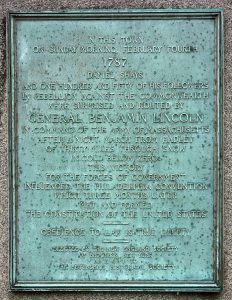Shays’ Rebellion helped highlight to Congress the need to strengthen and establish a stronger centralized government so the government could better respond to crisis situations like Shays’ Rebellion. The result of this event would be more support for the Constitution, and two new branches of government. So, while Shays’ Rebellion was defeated, and Congress wrote the Constitution, it would need to be ratified to replace the Articles of Confederation. It had to be sent to each state, and each

Daniel Shays’ Rebellion marker, June 7, 2013, by Daderot, via Wikimedia Commons.
state then voted among its representatives to ratify the Constitution. This would not be such a big thing, events at this level often went above the heads of poor farmers, but this is not the case in Massachusetts. Shays’ Rebellion had stirred the pot, and many in rural areas of Massachusetts now questioned the intention of the delegates at the Philadelphia Convention. They feared it “was just another aristocratic weapon to crush the “little people.” [1] The fear that had grown can easily be shown through the numbers that attended in 1786, when towns had been called for representatives, only 190 men went. However, in 1788, during the constitution ratification, it ballooned to 364. [2]
However, the Anti-Federalist fear of the Constitution had not spread throughout all of Massachusetts, there was a division. There had been a rift between the East and the West of Massachusetts long before Shays’ Rebellion. The poor western farmers that rose up against what they saw as a repressive government only worked to make the resentment between the two sides worse. [3] The people of western Massachusetts saw themselves as victims of a government taking advantage, and they saw the east as the face of that government taking coin out of their pockets. Even four years after the death of Daniel Shays in 1825, a Berkshire historian wrote “too much, however, had been said and done, to permit the feelings of the people at once to become altogether friendly. Unhappy jealousies remained in neighborhoods and towns.” [4] Despite the state having much of the same religion, race and culture in common, the division among poor rural people and the richer people in cities like Boston was an old contention that surfaced with Shays Rebellion and festered. Massachusetts was more divided in 1788 than it ever had been. Next ->
_____________________________________________________________________________________________________________________________________________________________
[1] Leonard L. Richards, Shays’s Rebellion: The American Revolution’s Final Battle (Philadelphia: University of Pennsylvania Press, 2002), 144.
[2]Ibid.
[3] Richard D. Brown, “Shays’s Rebellion and the Ratification of the Federal Constitution in Massachusetts,” in Beyond Confederation: Origins of the Constitution and American National Identity, ed. Richard Beeman, Stephen Botein and Edward C. Carter II (Chapel Hill: The University of North Carolina Press, 1987), 121.
[4] Ibid, 122.